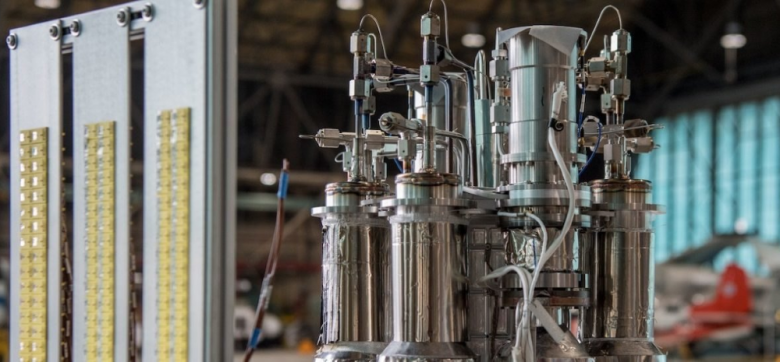
U.S. NUCLEAR SPACE

WNN - The National Aeronautics and Space Administration (NASA) announced the successful testing of a uranium-fuelled Stirling engine for use in possible future missions to Mars. Testing of the Kilopower reactor - which could be used to provide power to missions to the Moon, Mars and beyond - began at NASA's Nevada National Security Site in November 2017 and was completed in March.
The Kilopower reactor could produce 1-10 kilowatts of electrical power, continuously for ten years or more. The prototype power system uses a solid, cast uranium-235 reactor core. Reactor heat is transferred via passive sodium heat pipes, with the heat then converted to electricity by high-efficiency Stirling engines. Such engines use heat to create pressure forces that move a piston, which is coupled to an alternator to produce electricity.
A demonstration of the Kilopower technology - referred to as the Kilopower Reactor Using Stirling Technology (Krusty) experiment - was conducted jointly by NASA and the Department of Energy's National Nuclear Security Administration (NNSA). The experiment was conducted in four phases. The first two - conducted without power - confirmed that each component of the system behaved as expected. During the third phase, power was incrementally increased to heat the core before moving to the final phase. This was a full-power test lasting some 28 hours that simulated a mission, including reactor startup, ramp to full power, steady operation and shutdown. Throughout the experiment, the team simulated power reduction, failed engines and failed heat pipes, showing that the system could continue to operate and successfully handle multiple failures.
"We threw everything we could at this reactor, in terms of nominal and off-normal operating scenarios and Krusty passed with flying colours," said David Poston, chief reactor designer at NNSA's Los Alamos National Laboratory.
Marc Gibson, lead Kilopower engineer at NASA's Glenn Research Center in Cleveland, added: "We put the system through its paces. We understand the reactor very well, and this test proved that the system works the way we designed it to work. No matter what environment we expose it to, the reactor performs very well."
He added, "Kilopower gives us the ability to do much higher power missions, and to explore the shadowed craters of the Moon. When we start sending astronauts for long stays on the Moon and to other planets, that's going to require a new class of power that we've never needed before."
Space missions require reliable, long-lasting power sources both for propulsion once they are in space and to power experiments and equipment. Radioisotope thermoelectric generators (RTGs) have been widely used as power sources in satellites and other space vehicles such as the Mars rover Curiosity. However, virtually all RTGs are usually powered by plutonium-238, which is now in short supply.
Jim Reuter, NASA acting associate administrator for the Space Technology Mission Directorate, noted, "Safe, efficient and plentiful energy will be the key to future robotic and human exploration. I expect the Kilopower project to be an essential part of lunar and Mars power architectures as they evolve."
-----
Earlier:

2018, May, 2, 13:00:00
U.S. NUCLEAR AWARDS $60 MLNU.S. DOE - U.S. Secretary of Energy Rick Perry announced today that the U.S. Department of Energy (DOE) has selected 13 projects to receive approximately $60 million in federal funding for cost-shared research and development for advanced nuclear technologies. |

2018, April, 30, 10:05:00
U.S. - FRANCE NUCLEAR COOPERATIONWNN - A statement of intent to strengthen cooperation on fast neutron sodium-cooled reactors has been signed between the US Department of Energy (DOE) and the French Alternative Energies and Atomic Energy Commission (CEA). The partners have also a statement of intent to begin cooperation in the field of artificial intelligence. |

2018, March, 26, 07:35:00
U.S. NUCLEAR: $1.2 BLNWNN - Both houses of the US Congress have approved an omnibus appropriations bill including USD1.2 billion for nuclear energy. The bill will see the suspension of sales by the Department of Energy (DOE) of surplus uranium to pay for decommissioning work at the former Portsmouth uranium enrichment plant. |

2018, March, 11, 11:25:00
U.S. NUCLEAR UPWNN - Nuclear Energy Institute president and CEO Maria Korsnick said the bill's passage in the Senate was a "welcome and timely reminder" of the bipartisan support for innovative technologies in the US Congress. "Its provisions, once enacted into law, will go a long way to ensure the United States remains at the forefront of civilian nuclear capability," she said. |

2018, February, 14, 09:45:00
U.S. NUCLEAR WILL UPWNN - The USA has extended production tax credits for advanced nuclear power plants under a budget bill signed into law by President Donald Trump. The nuclear production tax credit is seen as an essential component for the completion of US plants already under construction and for first-of-a-kind small modular reactor (SMR) construction. |

2018, February, 5, 07:20:00
U.S. NUCLEAR RESILENCEDOE recently released a report that dives into the emerging technology of advanced small modular reactors (SMRs) and their ability to flexibly provide carbon-free power in response to outages caused by severe weather and physical threats to the grid. |

2018, January, 24, 11:35:00
U.S. NUCLEAR WATERSHEDWNN - US must maintain a strong domestic sector by keeping its reactors operating but must also demonstrate it can build new plants, while paving the way for advanced reactors |





